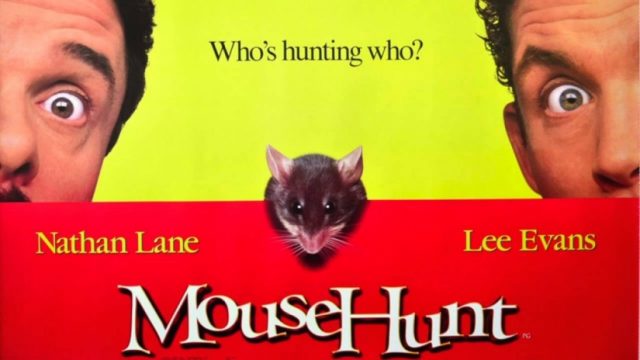It’s December 1997 and Nathan Lane is hot coming off of his star-making voice work in The Lion King and stealing every scene he’s in of The Birdcage. Lee Evans is also on fire after turning heads a few months back in There’s Something About Mary. The mouse? The mouse is about to heat up– as is Gore Verbinski’s career because MouseHunt is his directorial debut.
Gore Verbinski started directing NOFX and Bad Religion music videos before he jumped into directing commercials for big corporate products. 90’s kids will remember the Budweiser commercials with the frogs. That was him. So it makes sense that he went from directing one high-concept, irreverent tale of anthropomorphised animals to another.
MouseHunt opens with a somber organ. It’s a funeral in front of a church on a rainy dark day. Two men bear pall as they bicker over the casket’s weight distribution and the color of one of the their suit. The casket breaks, the body flies comically high into the air, does a few flips and lands perfectly inside an uncovered manhole. This man was the two men’s father. With that opening scene, Verbinski and company have their statement of intent.
MouseHunt, like many Gore Verbinski films, is a live-action cartoon. This version is in the vein of Wile E. Coyote and the Road Runner. Through some very bad luck, the brothers find themselves broke but through some good luck find out they’re sitting on a gold mind of a Victorian house their father left them. They set out to renovate and have a bit of a mouse problem. The plot is simple and very silly. But in the immortal words of Roger Ebert, “It’s not what a movie is about, it’s how it is about it.” And how MouseHunt is about it is very good.
The brothers are driven by low self-esteem, greed and an aching societal push to matter. The mouse’s motivations are less developed. At first it looks like he just doesn’t want to die but as the movie plays on and we get a little backstory we’re not so sure he doesn’t have an agenda of his own. As the film went on I began to wonder if he was an anarchist who was there to push back on the humans who abuse power in order to enrich themselves. There are many subplots and bits of dialogue in the film where humans are giving into their desperation to amass wealth for the sake of it. Unfortunately, the final scene dashed any hopes of the Mouse replacing Gritty as a leftist icon.
Even though thematically MouseHunt does not stick the landing, Verbinski’s knack for dark humor and lively action setpieces really makes this movie an enriching experience. The casting of Nathan Lane and Lee Evans for their verbal quips, ticks and facial expressions dovetail seamlessly with the stylized zaniness of MouseHunt. Technically, the movie works. Verbinski became well-known for his eye on informing spatial geography through compositions and editing. It’s in full display in every kinetic scene involving action or lots of movement (mouse hunting). Repeatedly, the movie visually introduces a bread crumb of cringe-inducing intrigue that inevitably brings physical pain to the brothers and much laughter for the audience. The top notch action mixed in with the slapstick and double entendres (how did this get a PG rating?) entertain very well but the backbone of the film is Alan Silvestri’s score. Like the film, the score is gleefully unsubtle. The macabre organs play up the veneer of reminding is that something sad or scary is happening while the mischievous brass never lets us forget that this is a playful mouse no matter how sociopathic his actions. Striking the right tone in a film like this matters and Silvestri does his part.i
Twenty one years later, and MouseHunt has become a forgotten gem. Perhaps this is because on the surface it seems like a dumb kids movie that no one over the age of ten would care for. But like all Gore Verbinski films, there’s more than meets the eye with MouseHunt. It’s entertaining and funny, the characters are compelling and if you squint you can find class commentary from the unlikeliest of sources.

